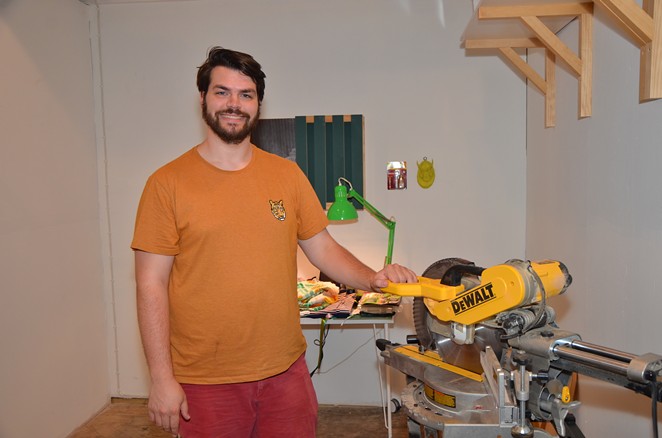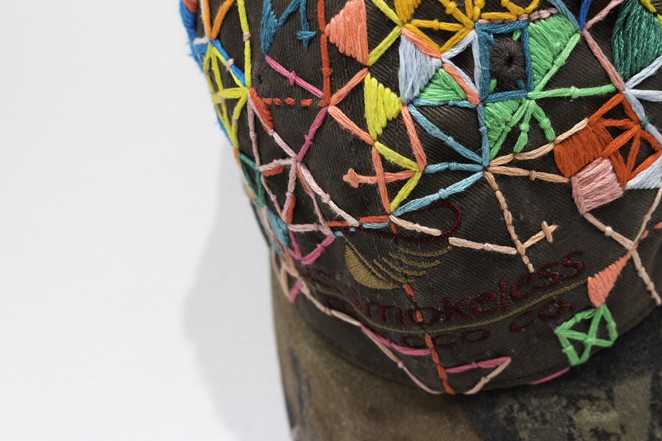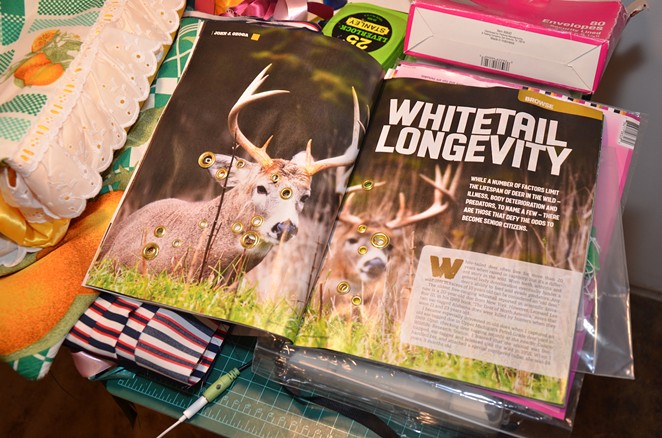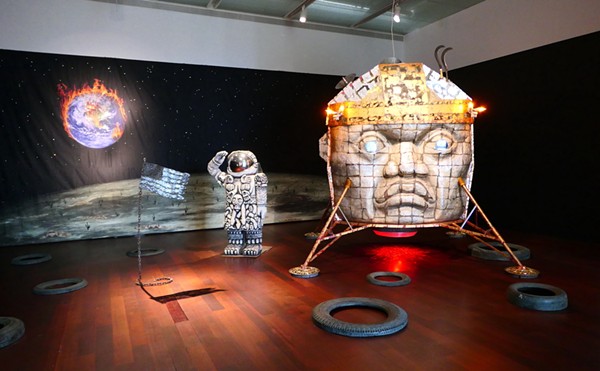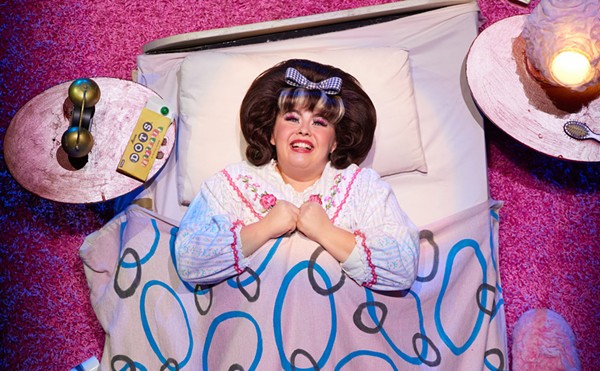Studio Visits: Iowa Transplant Justin Korver on Tweaking Gender Stereotypes and Finding His Way as a Fabricator
By Bryan Rindfuss on Thu, Sep 12, 2019 at 12:34 pm
Did you know you can take a sewing machine onto an airplane? That fancy chickens live in suburbia? Or that Vincent Van Gogh ate paint? These are but a few of the unusual factoids that bubbled up in conversation during our recent studio visit with Justin Korver, a talented multimedia artist who made his way to San Antonio from a tiny town in northwestern Iowa.
Born in the Dutch community of Sioux Center, Korver got an unlikely introduction to art from a high school gym teacher.
“To his credit,” Korver said, “he did recognize that I was passionate and let me do what I wanted to do.”
What the young Korver “wanted to do” entailed repeating art classes he’d already passed and printing photographs in the school darkroom during study hall. With assistance from “a terrible guidance counselor who will remain unnamed,” Korver found his next academic chapter at Hope College, a small liberal arts school in Holland, Michigan. (Fun fact: San Antonio-based artists Nate Cassie, Karen Mahaffy and Eden Collins also attended Hope College.)
“So I moved from one small Dutch community to another slightly larger, small Dutch community,” Korver mused. At Hope, he worked through the inevitable phases associated with finding oneself as an artist. “A lot of [my work] was trash, because you’re in undergrad,” he said with a laugh. “You have to work through all that angsty ‘I have too many feelings and not enough skills.’”
In the midst of his undergrad frustration, Korver arrived at a crossroads by challenging himself to bypass some of the formalities of art.
“My dad is a carpenter and a contractor, and my brother is now a contractor too and has worked in factories,” he explained. “So I was like, ‘What if I just made things that were more like building? So it’s less like making art and more like fabricating things.”
Not fond of working exclusively with paint, clay or any other single medium, Korver began embracing the possibilities of fabrication and shifted away from brushes to tools one might find in a garage or hardware store.
In the process of adopting skills and practices he associated with his father, Korver began exploring themes associated with masculinity. He had always hated shoveling snow, mowing the lawn and other “dude jobs” around the house.
“I realized that most of the reason I disliked them is because they’re isolating … And I don’t really like to be alone,” he confessed.
Instead he was drawn to chores that entailed a human connection like cooking and other tasks often stereotyped as feminine. Expanding on both personal experiences and expectations associated with gender, Korver began creating sculptures with techniques and materials associated with home construction — lumber, sheetrock, carpet padding, fiberglass insulation, fluorescent lighting, extension cords and latex paint.
With encouragement from a sculpture professor who’s friendly with local artist and educator Ken Little, Korver applied to a graduate program at UTSA and moved to San Antonio without ever having visited Texas. Studying under Little, Korver further developed the work he began during undergrad but was also pushed out of his sculptural comfort zone to explore other media such as video and performance work.
In 2016, Korver blipped the Current’s radar with “Accessories of Modern Men,” an MFA thesis exhibition built around the trinity of masculinity, domesticity and modernism.
“I actually still think those three things got really closely linked,” Korver said of his thesis. “The definition of ‘great art’ in the modern period was masculine genius … So I wanted to make things that kind of made fun of that.”
Although anchored by a visually arresting, wall-sized collage of archery targets, the solo show contained quieter curiosities including To Male Physique, a series of reconfigured and relabeled trophies topped with athletic-looking men, and The Rag You Clean Your Brush On, an installation of artfully stained towels hung from two adjacent towel racks. While it might not have been apparent to viewers, one of those towels was stained in the vein of a Mark Rothko painting and the piece was named after Alberto Giacometti’s suggestion that the real challenge of abstract painting is to create something as good as the rag you clean your brushes on.
Speaking about the various components of “Accessories of Modern Men,” Korver said, “I’m hesitant to use this word, but I do think it’s what I’m doing: it’s the ‘queering’ of the object. And the reason I’m hesitant about it is that I don’t want to be appropriative of that idea, but I think that my work comes so much out of feminist critique that it is that — ‘queering’ is the most productive intellectual space for the analysis of masculinity from a feminist perspective.”
Korver is now a full-time lecturer at Texas A&M San Antonio and among the handful of local artists who work out of Beacon Hill’s Clamp Light Artist Studios and Gallery. Upon entering Korver’s studio — which he shares with his “supportive, amazing” fiancée Alyssa Richards — the first elements to make an impression quickly echo his self-acceptance as a “fabricator.” A large circular saw dominates the room while drills, hand-held saws, pliers, screwdrivers, wrenches and vice grips hang neatly on pegboard. Plastic bins are labeled “Electrical,” “Rope,” “Bungees,” “Sanding” and “Safety.”
On the walls are photographs Korver shot in the suburbs of San Antonio — printed on mesh and framed in a fashion that evokes picket fencing. The aforementioned fancy chickens were among the surprises he encountered while working on these pieces for a group show exploring the increasingly pervasive concept of surveillance.
On the floor, work gloves Korver cast in concrete are lined up like severed appendages in Dr. Frankenstein’s laboratory — leftovers from his participation in the Tricentennial exhibition series “Common Currents.” Given the year 1901 as a point of departure, Korver found a newspaper article from that year titled “Artist Dies From Hunger.” In addition to a painted concrete glove, his contribution to “Common Currents” featured an empty lunch bag on which he wrote “They say Vincent Van Gogh ate his paints.” Combined with his affection for absinthe, Van Gogh’s alleged habit of ingesting turpentine and — specifically yellow — paint may have contributed to his insanity and bizarre behavior.
“To me it’s like that untenable thing,” Korver said. “We create this cult of the ‘starving bohemian artist,’ which makes us all starving bohemian artists, and makes people not value what we do. We’re kind of perpetuating that myth — and it also creates this whole fantasy where [being] mentally ill is somehow a good thing for your work, which we know it’s not. It wasn’t for Van Gogh. So it became about lots of things.”
Bringing to mind an eclectic garage sale, a small table along the back wall of Korver’s studio is stacked with colorful flags he fashioned during recent artist residencies in Berlin, through Blue Star Contemporary, and Mexico City, through Casa Lu. By the time he departed San Antonio for Germany on what was his first international trip, Korver had already decided that his time in Berlin would be spent sewing flags and therefore opted to travel with a sewing machine.
“You can take a sewing machine in a carry-on bag, which I was shocked by,” he said. “You have to take the needle out, but you can take the sewing machine.”
Pieced together from intentionally mismatched fabrics and destined for a Blue Star show next year, Korver’s flags are creative responses to conversations about nationalism and woes of the Trump era.
“One of the phrases I wrote in my sketchbook while I was thinking about it in Germany was, ‘Maybe nationalism is a kind of homophobia … the fear of the penetration of the border of the body of the state that causes all of these other things,” he said. Possibly the strangest thing on display in Korver’s studio is an unopened package of Special Golden Estrus — “fresh and super-premium doe urine” hunters use to lure bucks to their death. That, along with a copy of Deer & Deer Hunter magazine Korver strategically punctured with metal grommets, is research for a forthcoming hunting-themed exhibition Korver will unveil in October at Palo Alto College.
Though he only recently moved into Clamp Light, Korver already likes the feel.
“Lots of artists love to be alone in a studio and just focus and pour themselves into the work all day … That’s not what I want at all,” he said. “My ideal situation would be sitting with at least one other person in the studio while you’re both working, or chatting, or gossiping, or arguing about something. I even like to convince other people to do that with me. I’ve done trades with people where I tell them, ‘I’ll be your assistant if you’ll be my assistant.’ And honestly, it’s nice to have help, but it’s also because I love to have somebody else [around].”
Those people Korver likes having around should consider themselves lucky. Not only is he a bright, funny, insightful individual with a wealth of knowledge and colorful anecdotes, he delights in working collaboratively.
“For me, [making art is] a lot about connectedness,” he said. “It’s a lot about the people that you get to know, about getting to go and do exciting new things with people — [that’s] half the reason to be an artist.” Unsurprisingly, he also geeks out on problem-solving. “I find it really satisfying to find the exact piece of hardware to do something,” he said. “Even the tools, like finding the simplest way to do something is really gratifying to me. I love when somebody has a problem putting something together and I’m like, ‘What if you just did it like this?’ That’s my favorite feeling in the world.”
Stay on top of San Antonio news and views. Sign up for our Weekly Headlines Newsletter.
Born in the Dutch community of Sioux Center, Korver got an unlikely introduction to art from a high school gym teacher.
“To his credit,” Korver said, “he did recognize that I was passionate and let me do what I wanted to do.”
What the young Korver “wanted to do” entailed repeating art classes he’d already passed and printing photographs in the school darkroom during study hall. With assistance from “a terrible guidance counselor who will remain unnamed,” Korver found his next academic chapter at Hope College, a small liberal arts school in Holland, Michigan. (Fun fact: San Antonio-based artists Nate Cassie, Karen Mahaffy and Eden Collins also attended Hope College.)
“So I moved from one small Dutch community to another slightly larger, small Dutch community,” Korver mused. At Hope, he worked through the inevitable phases associated with finding oneself as an artist. “A lot of [my work] was trash, because you’re in undergrad,” he said with a laugh. “You have to work through all that angsty ‘I have too many feelings and not enough skills.’”
In the midst of his undergrad frustration, Korver arrived at a crossroads by challenging himself to bypass some of the formalities of art.
“My dad is a carpenter and a contractor, and my brother is now a contractor too and has worked in factories,” he explained. “So I was like, ‘What if I just made things that were more like building? So it’s less like making art and more like fabricating things.”
Not fond of working exclusively with paint, clay or any other single medium, Korver began embracing the possibilities of fabrication and shifted away from brushes to tools one might find in a garage or hardware store.
In the process of adopting skills and practices he associated with his father, Korver began exploring themes associated with masculinity. He had always hated shoveling snow, mowing the lawn and other “dude jobs” around the house.
“I realized that most of the reason I disliked them is because they’re isolating … And I don’t really like to be alone,” he confessed.
Instead he was drawn to chores that entailed a human connection like cooking and other tasks often stereotyped as feminine. Expanding on both personal experiences and expectations associated with gender, Korver began creating sculptures with techniques and materials associated with home construction — lumber, sheetrock, carpet padding, fiberglass insulation, fluorescent lighting, extension cords and latex paint.
With encouragement from a sculpture professor who’s friendly with local artist and educator Ken Little, Korver applied to a graduate program at UTSA and moved to San Antonio without ever having visited Texas. Studying under Little, Korver further developed the work he began during undergrad but was also pushed out of his sculptural comfort zone to explore other media such as video and performance work.
In 2016, Korver blipped the Current’s radar with “Accessories of Modern Men,” an MFA thesis exhibition built around the trinity of masculinity, domesticity and modernism.
“I actually still think those three things got really closely linked,” Korver said of his thesis. “The definition of ‘great art’ in the modern period was masculine genius … So I wanted to make things that kind of made fun of that.”
Although anchored by a visually arresting, wall-sized collage of archery targets, the solo show contained quieter curiosities including To Male Physique, a series of reconfigured and relabeled trophies topped with athletic-looking men, and The Rag You Clean Your Brush On, an installation of artfully stained towels hung from two adjacent towel racks. While it might not have been apparent to viewers, one of those towels was stained in the vein of a Mark Rothko painting and the piece was named after Alberto Giacometti’s suggestion that the real challenge of abstract painting is to create something as good as the rag you clean your brushes on.
Speaking about the various components of “Accessories of Modern Men,” Korver said, “I’m hesitant to use this word, but I do think it’s what I’m doing: it’s the ‘queering’ of the object. And the reason I’m hesitant about it is that I don’t want to be appropriative of that idea, but I think that my work comes so much out of feminist critique that it is that — ‘queering’ is the most productive intellectual space for the analysis of masculinity from a feminist perspective.”
Korver is now a full-time lecturer at Texas A&M San Antonio and among the handful of local artists who work out of Beacon Hill’s Clamp Light Artist Studios and Gallery. Upon entering Korver’s studio — which he shares with his “supportive, amazing” fiancée Alyssa Richards — the first elements to make an impression quickly echo his self-acceptance as a “fabricator.” A large circular saw dominates the room while drills, hand-held saws, pliers, screwdrivers, wrenches and vice grips hang neatly on pegboard. Plastic bins are labeled “Electrical,” “Rope,” “Bungees,” “Sanding” and “Safety.”
On the walls are photographs Korver shot in the suburbs of San Antonio — printed on mesh and framed in a fashion that evokes picket fencing. The aforementioned fancy chickens were among the surprises he encountered while working on these pieces for a group show exploring the increasingly pervasive concept of surveillance.
On the floor, work gloves Korver cast in concrete are lined up like severed appendages in Dr. Frankenstein’s laboratory — leftovers from his participation in the Tricentennial exhibition series “Common Currents.” Given the year 1901 as a point of departure, Korver found a newspaper article from that year titled “Artist Dies From Hunger.” In addition to a painted concrete glove, his contribution to “Common Currents” featured an empty lunch bag on which he wrote “They say Vincent Van Gogh ate his paints.” Combined with his affection for absinthe, Van Gogh’s alleged habit of ingesting turpentine and — specifically yellow — paint may have contributed to his insanity and bizarre behavior.
“To me it’s like that untenable thing,” Korver said. “We create this cult of the ‘starving bohemian artist,’ which makes us all starving bohemian artists, and makes people not value what we do. We’re kind of perpetuating that myth — and it also creates this whole fantasy where [being] mentally ill is somehow a good thing for your work, which we know it’s not. It wasn’t for Van Gogh. So it became about lots of things.”
Bringing to mind an eclectic garage sale, a small table along the back wall of Korver’s studio is stacked with colorful flags he fashioned during recent artist residencies in Berlin, through Blue Star Contemporary, and Mexico City, through Casa Lu. By the time he departed San Antonio for Germany on what was his first international trip, Korver had already decided that his time in Berlin would be spent sewing flags and therefore opted to travel with a sewing machine.
“You can take a sewing machine in a carry-on bag, which I was shocked by,” he said. “You have to take the needle out, but you can take the sewing machine.”
Pieced together from intentionally mismatched fabrics and destined for a Blue Star show next year, Korver’s flags are creative responses to conversations about nationalism and woes of the Trump era.
“One of the phrases I wrote in my sketchbook while I was thinking about it in Germany was, ‘Maybe nationalism is a kind of homophobia … the fear of the penetration of the border of the body of the state that causes all of these other things,” he said. Possibly the strangest thing on display in Korver’s studio is an unopened package of Special Golden Estrus — “fresh and super-premium doe urine” hunters use to lure bucks to their death. That, along with a copy of Deer & Deer Hunter magazine Korver strategically punctured with metal grommets, is research for a forthcoming hunting-themed exhibition Korver will unveil in October at Palo Alto College.
Though he only recently moved into Clamp Light, Korver already likes the feel.
“Lots of artists love to be alone in a studio and just focus and pour themselves into the work all day … That’s not what I want at all,” he said. “My ideal situation would be sitting with at least one other person in the studio while you’re both working, or chatting, or gossiping, or arguing about something. I even like to convince other people to do that with me. I’ve done trades with people where I tell them, ‘I’ll be your assistant if you’ll be my assistant.’ And honestly, it’s nice to have help, but it’s also because I love to have somebody else [around].”
Those people Korver likes having around should consider themselves lucky. Not only is he a bright, funny, insightful individual with a wealth of knowledge and colorful anecdotes, he delights in working collaboratively.
“For me, [making art is] a lot about connectedness,” he said. “It’s a lot about the people that you get to know, about getting to go and do exciting new things with people — [that’s] half the reason to be an artist.” Unsurprisingly, he also geeks out on problem-solving. “I find it really satisfying to find the exact piece of hardware to do something,” he said. “Even the tools, like finding the simplest way to do something is really gratifying to me. I love when somebody has a problem putting something together and I’m like, ‘What if you just did it like this?’ That’s my favorite feeling in the world.”
Stay on top of San Antonio news and views. Sign up for our Weekly Headlines Newsletter.

KEEP SA CURRENT!
Since 1986, the SA Current has served as the free, independent voice of San Antonio, and we want to keep it that way.
Becoming an SA Current Supporter for as little as $5 a month allows us to continue offering readers access to our coverage of local news, food, nightlife, events, and culture with no paywalls.
Scroll to read more Arts Stories & Interviews articles
Newsletters
Join SA Current Newsletters
Subscribe now to get the latest news delivered right to your inbox.

